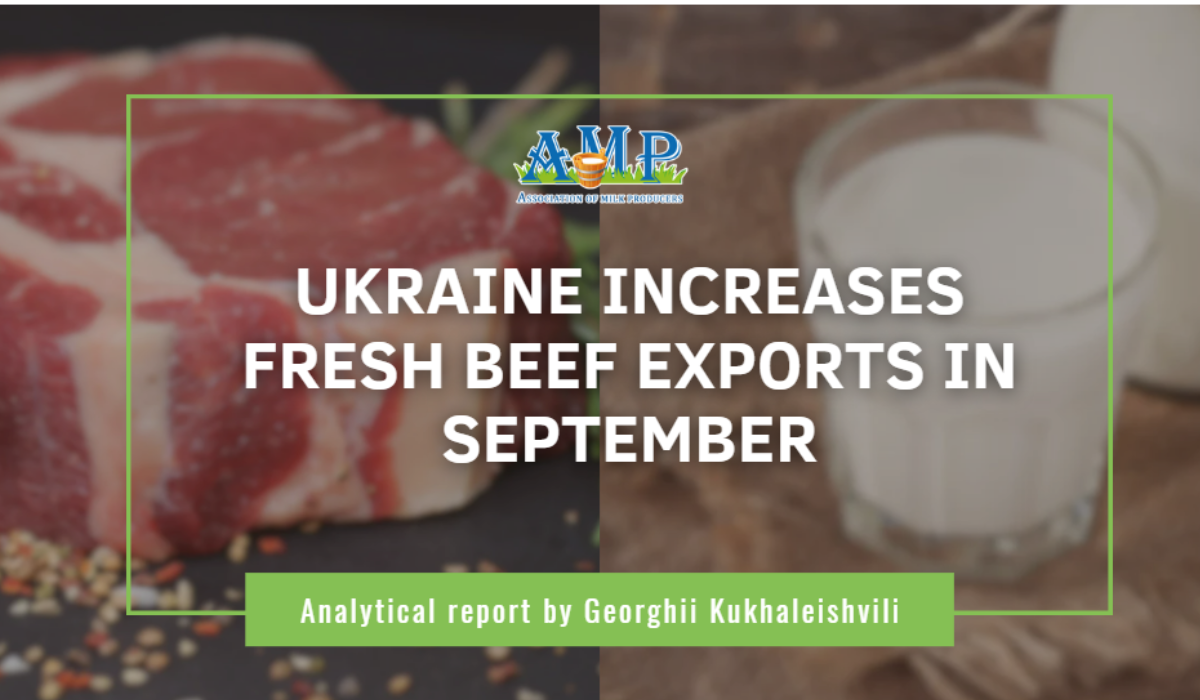Import demand for beef in the US and China is driving up cattle prices, reports Georghii Kukhaleishvili, analyst at the Association of Milk Producers (AMP).
According to preliminary data from the State Statistics Service of Ukraine (SSSU), in September 2025, Ukraine exported approximately 558 tonnes of cattle (live weight), which is 45% less than August 2025 and 73% less than September 2024. The revenue from exported animals amounted to $782 thousand, a 72% decrease compared to August 2025 and an 82.4% decrease compared to September 2024. From January to September 2025, Ukraine exported 13.28 thousand tonnes of cattle live weight (+27%) worth $29.21 million (+52%). Throughout the first nine months of 2025, the key destinations for Ukrainian cattle exports were Lebanon (87%), Libya (7.6%), Kazakhstan (4%), and Uzbekistan (+1%).
In September 2025, Ukrainian exporters supplied 104 tonnes of fresh or chilled beef to foreign markets, which is nearly 5.5 times more than August of the current year and almost 130 times more than September 2024. Export revenue for the supplied goods amounted to $621 thousand, which is 6 times more than August 2025 and 58 times more than September 2024. From January to September 2025, Ukraine shipped 224 tonnes of chilled beef (-75%) to foreign markets worth $1.31 million (-76%). The key destinations for fresh beef exports from Ukraine since the beginning of 2025 were Georgia (36.41%), Jordan (27%), Azerbaijan (25.44%), and Moldova (10.43%).
The natural volume of frozen beef exports from Ukraine in September 2025 was 1.17 thousand tonnes, which is 13.4% less than August of the current year and 26% less than September 2024. Revenue for the supplied goods was nearly $5.45 million, which is 12% less than August 2025 and 11% less than September 2024. From January to September 2025, Ukraine exported 13.8 thousand tonnes of frozen beef (+9.8%) worth $56.78 million (+11.7%). Since the beginning of the year, the largest shipments of frozen beef went to China (30.5%), Azerbaijan (30%), Uzbekistan (17%), Kazakhstan (8%), and Moldova (6%).
Georghii Kukhaleishvili notes that the high demand for Australian beef from the US and China is pushing up global prices for red meat and cattle. This year, American farmers reduced cattle supply to the market, which raised wholesale beef prices to record levels. In China, Australian beef has effectively replaced US supplies due following a trade dispute with the Trump administration. Furthermore, the US introduced high tariffs on imports from Brazil, further limiting beef supply on the American market. The high demand for beef in the US is due to Americans consuming more steaks and ground beef recently, and the demand for high-quality beef is driving up retail prices.
High export demand contributed to price stabilization in Australia, increased margins for processors, and competition for slaughter cattle. Declining grain prices and improved feed availability supported calf prices, and limited supply maintained stable cow prices. Specifically, in Ukraine in September, bulls weighing over 400 kg cost 106–112 UAH/kg, and well-conditioned cows cost 96–105 UAH/kg. Animal prices increased by 2% over the last month. As of the first half of October, the price for bulls continued to rise, reaching 108–115 UAH/kg. Record-high cattle prices are contributing to farmers in producing regions selling more often rather than expanding their herds, which limits supply. Farmers are in no rush to rebuild their herds due to risks and economic costs.
According to the Elders forecast, a certain easing of global beef prices is likely as an increase in slaughter is expected in the US in the fourth quarter. Farms are gradually selling accumulated cattle, which may slightly reduce global beef prices. Increased slaughter of dairy cows in the US is helping to stabilize prices for Australian cattle. Meat & Livestock Australia reports changes in price dynamics for heavy steers and cows for processing since mid-September. Heavy steer prices were rising, reaching a 12-month high of 438 cents per kg, while prices for processing cows dropped by 7% over the last three weeks. The decline in cow prices occurred after the US summer and grilling season ended. Heavy steer prices remained high due to strong demand from processors aiming to obtain more kilograms of meat from each animal. However, the upward trend in heavy steer prices ended in early October, and they began to align with prices for slaughter cows.
In September 2025, Ukraine did not import cattle (live weight). Imports of chilled beef decreased to 11 tonnes (-27%), and frozen beef imports increased to 72 tonnes (+18%) compared to August 2025. Chilled beef imports decreased by 42%, and frozen beef imports decreased by 68% compared to September 2024. From January to September 2025, Ukraine increased live cattle imports to 512 tonnes (+9%) but reduced imports of chilled beef to 106 tonnes (-2%) and frozen beef to 1.07 thousand tonnes (-44%) compared to the same period last year.
The trade balance in September 2025 was positive, amounting to $5.97 million.
Press service of the Association of Milk Producers
Follow us on LinkedIn
Related News
Irish Documentarian Caolan Robertson on the Crimes of Russian Aggression. Video


